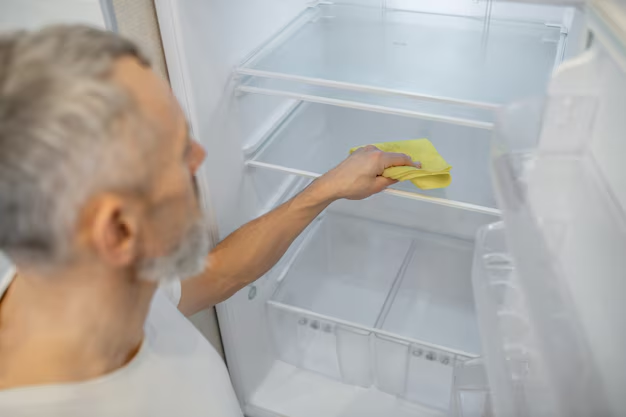Keeping Your Fridge Efficient: A Complete Guide to Cleaning Refrigerator Condenser Coils
Is your refrigerator not cooling as effectively as it used to? A little-known fact is that the condenser coils might be the culprit. These coils play a crucial role in the cooling efficiency of your refrigerator, and when they get dirty, energy consumption increases, and cooling capacity decreases. This guide offers a comprehensive look at how to clean your refrigerator's condenser coil, ensuring optimal performance and energy efficiency.
🌀 Understanding the Role of Condenser Coils
Before diving into the cleaning process, it's important to understand what condenser coils do. Located either at the back or the bottom of your refrigerator, these coils release heat from the inside of the fridge to the outside air. When coated with dust and grime, they can't effectively dissipate heat, causing your fridge to work harder and less efficiently.
Why Keeping Coils Clean is Essential
- Energy Efficiency: Dirty coils make your refrigerator consume more energy, increasing your utility bills.
- Cooling Performance: Clogged coils can lead to warmer fridge temperatures, compromising food safety.
- Extended Lifespan: Regular maintenance prevents strain on the compressor, potentially extending the life of your refrigerator.
Now that we've established their importance, let's explore how to maintain them.
🛠 Preparing to Clean the Condenser Coils
For safety and efficiency, it's important to prepare adequately before cleaning the coils. Here’s what you need to know:
Essential Tools
- Vacuum Cleaner: A vacuum with a hose attachment is ideal for removing loose dust.
- Coil Brush: This special brush is flexible and designed to reach tight spots around the coils.
- Soft Cloth: For wiping off residue after the initial dust removal.
- Screwdriver: If your model has a coil cover that needs unscrewing.
Safety Precautions
- Unplug the Refrigerator: This prevents electrical shock and allows the appliance to reset.
- Locate the Coils: Check your refrigerator manual to find out whether the coils are at the back or the bottom.
🧼 Step-by-Step Cleaning Process
Follow this guide to clean your refrigerator condenser coils effectively:
Step 1: Access the Coils
- Rear-Coil Models: Gently pull the fridge away from the wall to access the back.
- Bottom-Coil Models: Remove the bottom panel or grille as per the manufacturer's instructions.
Step 2: Initial Cleaning
- Use the vacuum cleaner to remove accumulated dust. Start from one end of the coil and move to the other, focusing on reaching between the fins.
- Be gentle to avoid bending the fins.
Step 3: Detailed Brushing
- Use the coil brush to dislodge stubborn grime.
- Gently insert the brush between the coils and move in a sweeping motion.
- Remove dislodged debris with the vacuum.
Step 4: Final Wiping
- Use a soft cloth to wipe any remaining dust around the coils and the surrounding area.
- Reattach any panels or covers securely.
🔄 Routine Maintenance Tips
Keeping the coils clean should be part of your regular refrigerator maintenance routine. Here's how often and what to do:
How Often to Clean
- Every Six Months: For a typical household, this frequency is recommended.
- Seasonal Adjustments: If you live in a dusty area or use the fridge more often, aim for every three months.
Additional Maintenance Tips
- Check for Ice Build-up: Excess ice can indicate blocked airflow paths, needing prompt attention.
- Ensure Proper Ventilation: Keep space around the refrigerator clear to help dissipate heat effectively.
📝 Common Mistakes to Avoid
While cleaning, it’s easy to make mistakes that could damage your fridge. Avoid these pitfalls:
- Using Metal Tools: Metal can damage coils or cause a short circuit.
- Neglecting to Secure Panels: Loose panels can disrupt airflow and reduce efficiency.
- Forgetting to Unplug: Always ensure the refrigerator is unplugged to prevent electrical hazards.
🤔 Frequently Asked Questions
How can I tell if my condenser coils are dirty?
Signs include warm refrigerator temperatures, the refrigerator running constantly, or higher electricity bills.
Can dirty coils cause refrigerator failure?
While unlikely to cause immediate failure, dirty coils strain the compressor over time, potentially leading to breakdowns.
What if I've lost the refrigerator's manual?
Most manufacturers provide manuals online. Alternatively, customer service can guide you on maintenance procedures.
🌟 Key Takeaways and Best Practices
Here’s a summary to help you keep your refrigerator working smoothly:
- 🔄 Maintain Regularly: Clean your coils every 3-6 months based on usage and environment.
- 🛡️ Ensure Safety: Always unplug your refrigerator during maintenance.
- 🧽 Use Proper Tools: A coil brush and vacuum cleaner are essential for effective cleaning.
- 🚫 Avoid Mistakes: Don't use metal tools and ensure all panels are reattached.
Cleaning your refrigerator's condenser coils may not top your list of fun tasks, but the benefits in energy savings and appliance longevity make it a worthwhile investment. By incorporating these practices into your regular cleaning routine, you're not just maintaining a refrigerator—you're ensuring that your home runs just a little bit smoother. Remember, a little bit of maintenance goes a long way in keeping those fresh groceries at their crisp, cool best.
